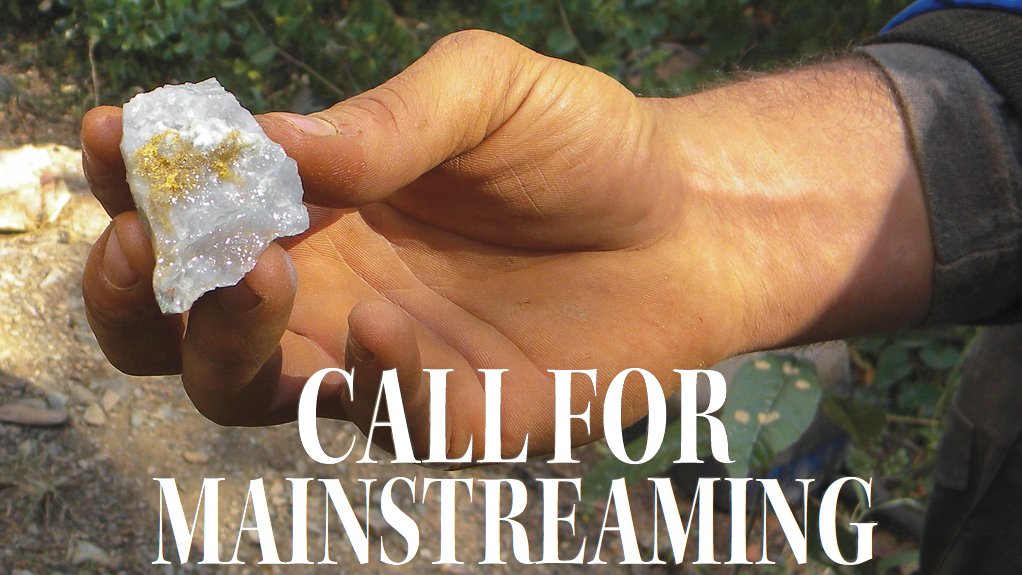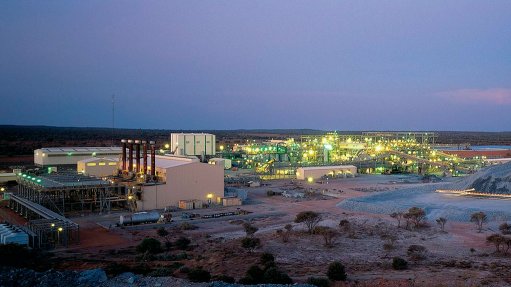Formalised status urged for artisanal, small-scale mining
JOHANNESBURG (miningweekly.com) – Members of community organisations and artisanal mining and academic communities, as well as civil society groups, have called on government and mining companies to uphold the rights of all South African mineworkers, including artisanal and small-scale miners.
ActionAid South Africa (AASA) mining and extractives coordinator Christopher Rutledge tells Mining Weekly that government’s current view of artisanal mining as a criminal activity is having a detrimental effect on an already marginalised group.
Several testimonies were given by artisanal and small-scale miners at the Artisanal Miners Are Not Criminals conference, which was cohosted last month by AASA and Mining Affected Communities United in Action, in Berea, Johannesburg. Rutledge says the conference demonstrated that artisanal miners were indeed marginalised and unemployed and had very little to no option but to look for alternative means of income.
University of the Witwatersrand anthropology professor Robert Thornton, who is investigating the relationship between current and ancient mining practices in precolonial Southern Africa, argues that artisanal mining should be viewed as a national heritage and not an illegal activity because of the correlation between current and ancient artisanal mining technologies and social structures.
He notes that people can financially support themselves through artisanal mining and nonalienated labour, as they receive remuneration through self- employment. “Everyone at these sites is pretty happy and not as desperate as they have been represented.”
Rutledge adds that artisanal and small-scale miners have a sense of pride because they can create employment for themselves. “What we are seeing in our work with artisanal and small-scale miners is that work affords people a sense of dignity and achievement. They are extremely proud of the fact that they work hard.”
Artisanal and small-scale miners are often young unemployed South Africans who are prepared to labour in difficult and even dangerous conditions to help alleviate the pressures of poverty.
“However, the way that they are being represented is holding them back, as the legal position on artisanal mining is denying them that opportunity by delegitimising their activities,” Rutledge says.
Thornton notes that his research on artisanal and small-scale miners in South Africa and Zimbabwe found artisanal mining sites to have a strong sense of community, as families and friends work together to produce the minerals that enable them to sustain themselves. The wealth generated through such mining is distributed evenly among community members, he says, noting that there is little disparity among the workers, which is typical of large-scale mining operations, with an identifiable elite and labour classes.
Meanwhile, Rutledge states that government’s focus on the formal mining sector to address the challenges of unemployment is unsustainable, particularly since the number of jobs in the sector has dropped from more than one-million to less than 400 000 in the past decade – a trend that is likely to continue.
“There are thousands of mineworkers who are operating abandoned South African mines fairly profitably,” he says, adding that “artisanal mining presents a real option for South Africa”, as it can add significant value in terms of job creation and economic inclusion of marginalised South Africans.
There is also a direct correlation between productive employment and a sense of dignity among people; however, once that sense of dignity is lost, social ills, such as crime and violence, begin to develop to the point of becoming a “pathology”, Rutledge states.
Artisanal and small-scale miners have no legal recourse when they are unfairly treated, because their activities are deemed illegal. Rutledge highlights that they are often discriminated against by the communities near their operations, receiving unfair prices for goods, for example. This often results in artisanal and small-scale miners and communities perpetrating crimes and violence against one another.
Rutledge notes that South Africa’s unemployment challenges – with the unemployment rate at 24.5%, according to Statistics South Africa – can be alleviated by formalising and regulating the artisanal mining sector.
“Artisanal and small-scale miners have been successfully integrated into the economy of several developing nations, such as Ghana, Uganda and Sierra Leone,” he highlights.
Artisanal miners can produce minerals very efficiently – Thornton’s research findings show that they are able to extract as much as 115 g/t of gold. Large-scale gold mines are considered to be profitable when they produce 10 g/t to 15 g/t of gold.
Artisanal miners can recover more gold for every ton mined because they select and remove only the best gold-bearing ore. Large-scale operations use explosives and draglines to remove significantly more rock material, but not necessarily material with the most gold-bearing ore, explains Thornton.
Further, less waste is generated by artisanal mining than large-scale operations because artisanal miners remove less material.
The Artisanal Miners Are Not Criminals conference resolved to invite other stakeholders, including the Department of Mineral Resources and the South African Police Service, to a conference in November to further discuss the challenges faced by artisanal miners in South Africa.
Meanwhile, a study headed by Thornton and National Museums and Monuments of Zimbabwe archaeologist Njabulo Chipangura is investigating the relationship between current artisanal mining practices and ancient mining practices in Southern Africa.
This could reshape the academic community’s view of Southern African economic activities before the advent of colonialism.
At a seminar held at the Wits Anthropology Museum in February, Thornton highlighted that a study found that artisanal gold mineworkers in Barberton, Mpumalanga, and in Roodepoort, Gauteng, used primitive tools, such as grinding stones, chisels and hammers, to break and crush gold-bearing rocks. Mercury was also used to extract the gold from any waste material.
This study, which he and Council for Scientific and Industrial Research researcher Elliot Moyo conducted, was first presented last year.
Thornton explained that artisanal mineworkers used their knowledge to visually select and sort gold-bearing rocks by hand, with the rocks then processed on site, pointing out that holes left in the ground caused by grinding activities were grouped closely together, which highlighted that it was a social activity.
Similar holes were also discovered near Mapungubwe, in South Africa, and in Zimbabwe, and it had been thought that these were created by grain-grinding activities. Thornton notes, however, that such grinding depressions would be shallower than those found in Barberton and Mapungubwe. This is because grain is soft and contains oils, which would lubricate the hard-rock surfaces and the grinding stones, suggesting that the depressions at the Zimbabwe World Heritage site were not created by grain- grinding activities.
Further, the depressions are grouped together, similar to those at South African sites. Thornton explains that women at contemporary artisanal mining sites form groups when grinding the gold ore, which could also have been the practice in ancient Southern Africa.
He states that these discoveries are challenging conventional wisdom, which, for example, postulates that ancient Southern African economies and the technologies used by societies at the time were not advanced enough to produce metallurgical goods, such as gold beads and bracelets.
The significant number of mining and metallurgical tools found at archaeological sites in Zimbabwe is evidence of societies with a sophisticated knowledge and a technology base that was not solely focused on cattle herding and agriculture, Thornton elaborates.
Those who had metallurgical knowledge were likely members of secret guilds, much like the ancient mining and metallurgical guilds in ancient Europe.
Ancient European mineworkers, particularly those in Germany and the UK, used similar tools and processes to those of their African contemporaries, he notes, adding, however, that it is possible that the European mineworkers travelled to Africa to seek more opportunities.
Thornton explains that nineteenth-century European mining equipment, such as chisels, have been discovered at archaeological sites in Zimbabwe. While chisels were used by African mineworkers before Europeans entered the continent, because European tools had a different steel composition, it is possible to ascertain their origin.
He suggests that African mineworkers, with their knowledge of the local geology, would have pointed out mineral-rich areas to their European counterparts, which, in turn, could have been the precursor to European mineral extraction in Southern Africa.
Thornton asserts that the first labourers on capital-intensive mines in colonial Rhodesia and in the Zuid Afrikaanse Republiek were likely to have been artisanal African mineworkers.
However, further investigation is needed to “better conceptualise the structure of early African societies that invested in mining and metallurgy”.
Thornton says new models of settlement, migration, trade and economies for the precolonial period, as well as for investigating how metals were used and integrated into Southern African societies and cultures, must be developed to determine the scale and sophistication of these ancient societies.
Comments
Press Office
Announcements
What's On
Subscribe to improve your user experience...
Option 1 (equivalent of R125 a month):
Receive a weekly copy of Creamer Media's Engineering News & Mining Weekly magazine
(print copy for those in South Africa and e-magazine for those outside of South Africa)
Receive daily email newsletters
Access to full search results
Access archive of magazine back copies
Access to Projects in Progress
Access to ONE Research Report of your choice in PDF format
Option 2 (equivalent of R375 a month):
All benefits from Option 1
PLUS
Access to Creamer Media's Research Channel Africa for ALL Research Reports, in PDF format, on various industrial and mining sectors
including Electricity; Water; Energy Transition; Hydrogen; Roads, Rail and Ports; Coal; Gold; Platinum; Battery Metals; etc.
Already a subscriber?
Forgotten your password?
Receive weekly copy of Creamer Media's Engineering News & Mining Weekly magazine (print copy for those in South Africa and e-magazine for those outside of South Africa)
➕
Recieve daily email newsletters
➕
Access to full search results
➕
Access archive of magazine back copies
➕
Access to Projects in Progress
➕
Access to ONE Research Report of your choice in PDF format
RESEARCH CHANNEL AFRICA
R4500 (equivalent of R375 a month)
SUBSCRIBEAll benefits from Option 1
➕
Access to Creamer Media's Research Channel Africa for ALL Research Reports on various industrial and mining sectors, in PDF format, including on:
Electricity
➕
Water
➕
Energy Transition
➕
Hydrogen
➕
Roads, Rail and Ports
➕
Coal
➕
Gold
➕
Platinum
➕
Battery Metals
➕
etc.
Receive all benefits from Option 1 or Option 2 delivered to numerous people at your company
➕
Multiple User names and Passwords for simultaneous log-ins
➕
Intranet integration access to all in your organisation





















